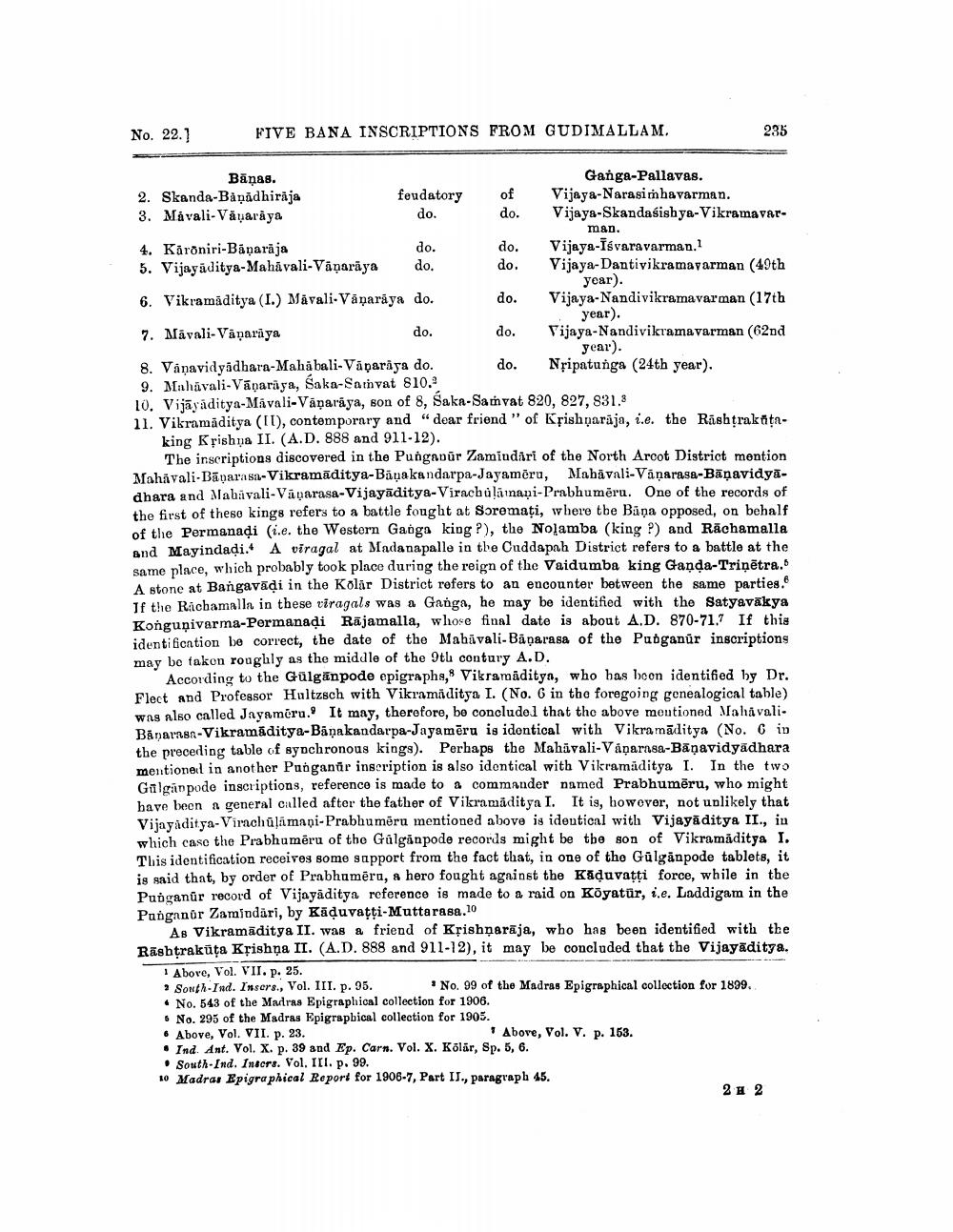________________
No. 22.]
FIVE BANA INSCRIPTIONS FROM GUDIMALLAM.
Bāņas.
2. Skanda-Baṇādhiraja
3. Mavali-Vanaraya
feudatory of
do.
do.
4. Karoniri-Baparja
5. Vijayaditya-Mahvali-Vanaraya
6. Vikramaditya (I.) Mavali-Vaparāya do.
7. Mavali-Vanaraya
do.
8. Vanavidyadhara-Mahabali-Vaparaya do. 9. Mahavali-Vaṇaraya, Saka-Samvat 810.2
do.
do.
do.
do.
do.
do.
do.
Ganga-Pallavas.
Vijaya-Narasimhavarman. Vijaya-Skandadiahya-Vikramavar
man.
Vijaya-Ivaravarman.1 Vijaya-Dantivikramavarman (49th
year).
Vijaya-Nandivikramavarman (17th
year).
Vijaya-Nandivikramavarman (62nd
year).
Nripatunga (24th year).
235
10. Vijayaditya-Mavali-Vanaraya, son of 8, Saka-Samvat 820, 827, 831.3
11. Vikramaditya (II), contemporary and "dear friend" of Krishnaraja, i.e. the Rashtrakutaking Krishna II. (A.D. 888 and 911-12).
The inscriptions discovered in the Punganur Zamindari of the North Arcot District mention Mahavali-Bapara sa-Vikramaditya-Bauakandarpa-Jayamēru, Mahavali-Vanarasa-Baṇavidyadhara and Mabavali-Vanarasa-Vijayaditya-Virachula nani-Prabhumēru. One of the records of the first of these kings refers to a battle fought at Soremați, where the Bana opposed, on behalf of the Permanaḍi (i.e. the Western Ganga king ?), the Nolamba (king ?) and Rachamalla and Mayindadi. A viragal at Madanapalle in the Cuddapah District refers to a battle at the same place, which probably took place during the reign of the Vaidumba king Ganda-Triņētra. A stone at Bangavaḍi in the Kōlär District refers to an encounter between the same parties. If the Rachamalla in these viragals was a Ganga, he may be identified with the Satyavakya Kongunivarma-Permanaḍi Rajamalla, whose final date is about A.D. 870-71.7 If this identification be correct, the date of the Mahivali-Baparasa of the Pubganür inscriptions. may be taken roughly as the middle of the 9th century A.D.
According to the Gülgänpode epigraphs, Vikramaditya, who has been identified by Dr. Flect and Professor Hultzsch with Vikramaditya I. (No. 6 in the foregoing genealogical table) was also called Jayamēru. It may, therefore, be concluded that the above mentioned MahavaliBanarasa-Vikramaditya-Banakandarpa-Jayamēru is identical with Vikramaditya (No. C in the preceding table of synchronous kings). Perhaps the Mahavali-Vanarasa-Baṇavidyadhara mentioned in another Punganur inscription is also identical with Vikramaditya I. In the two Gülganpode inscriptions, reference is made to a commander named Prabhumēru, who might have been a general called after the father of Vikramaditya I. It is, however, not unlikely that Vijayaditya-Virachūļāmani-Prabhumēru mentioned above is identical with Vijayaditya II., in which case the Prabhumeru of the Gülgänpode records might be the son of Vikramaditya I. This identification receives some support from the fact that, in one of the Gülgänpode tablets, it is said that, by order of Prabhumēru, a hero fought against the Kaduvatți force, while in the Punganur record of Vijayaditya reference is made to a raid on Köyatür, i.e. Laddigam in the Punganur Zamindari, by Kaḍuvațți-Muttarasa.10
As Vikramaditya II. was a friend of Krishnaraja, who has been identified with the Rashtrakuta Krishna II. (A.D. 888 and 911-12), it may be concluded that the Vijayaditya. 1 Above, Vol. VII. p. 25.
2 South-Ind. Insers., Vol. III. p. 95.
No. 543 of the Madras Epigraphical collection for 1906.
5 No. 295 of the Madras Epigraphical collection for 1905.
6 Above, Vol. VII. p. 23.
Ind. Ant. Vol. X. p. 39 and Ep. Carn. Vol. X. Kōlar, Sp. 5, 6. South-Ind. Inscrs. Vol. III. p. 99.
10 Madras Epigraphical Report for 1906-7, Part II., paragraph 45.
No. 99 of the Madras Epigraphical collection for 1899.
Above, Vol. V. P. 153.
2H 2




